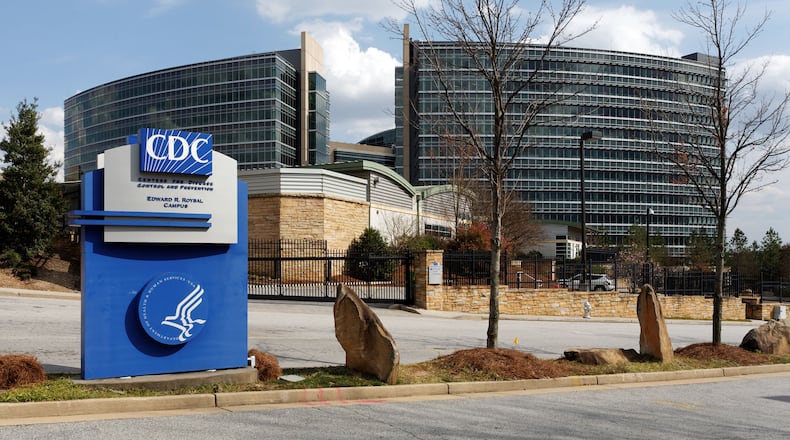In February 2021, three HIV clusters among Hispanic men in metro Atlanta were identified for the first time. By June 2022, two more clusters of HIV were detected, spreading rapidly among Hispanic men who are gay or bisexual and other men who have sex with men.
The cases and how they were discovered were described by one of the lead authors of a Centers for Disease and Prevention study on Tuesday at the agency’s annual Epidemic Intelligence Service (EIS) Conference in Atlanta.
Dr. David Philpott, a pediatrician who studied the HIV clusters in metro Atlanta, told of new tools being used across the country, including Georgia, to detect the disease. He also discussed what came next after the clusters were identified: the Georgia Department of Public Health and the CDC working together to quickly develop new strategies to link people with HIV or risk to HIV to care and treatment to prevent new infections.
The CDC study on the HIV clusters and the response is among 97 presentations featured this week at an Atlanta conference with EIS — better known as CDC’s “disease detectives” — who tackle a wide range of illnesses from COVID-19 and HIV to polio, gestational diabetes, and seasonal flu. This is the first time presenters and participants have met in person since the start of the pandemic.
Philpott, one of the EIS officers, explained that when someone tests positive for HIV, molecular analysis has been used to check for signs of drug resistance and can help determine which medicines will work best. In recent years, molecular analysis has been used to look for genetic changes in the HIV virus to identify networks of HIV transmission. HIV changes quickly, according to the CDC, and finding similar strains among a group of people can be a sign of rapid transmission.
Credit: Helena Oliviero
Credit: Helena Oliviero
In Georgia, the molecular surveillance detected five total HIV clusters with a total of 75 people infected with HIV — with 42 of them (equivalent to 56%) of them being Hispanic, far higher than what would be expected in an HIV cluster, In 2020, Hispanic people accounted for 9% of all new HIV diagnoses and 8% of people living with HIV/AIDS in Georgia, according to DPH.
In 2020, there were 57,561 people living with HIV in Georgia, according to data compiled by the AIDSVu project, based at Emory University’s Rollins School of Public Health. About 69% of those living with the disease are Black, 8% are Hispanic, 17% white.
In the fall of 2021, the Georgia Department of Public Health reached out to the CDC for help in better understanding the HIV clusters and the challenges to getting care. They interviewed 29 of those in the clusters, and barriers to accessing HIV services included language barriers including a lack of educational materials in Spanish, immigration and deportation-related concerns, and a lack of access to a primary care doctor. Contact tracers who reached those in the clusters helped link those who are HIV-positive to care. They also reached out to those who may be in the same network and who are HIV-negative and could benefit from HIV prevention treatment known as PrEP, which is a pill taken daily to prevent infection.
Philpott said the HIV clusters were concerning and called for “us to be thoughtful and think, what are we missing? What are the things we need to do?”
Philpott said he was proud of what he called a “true team effort,” by the CDC, state and local health departments, to work together to tackle this major health problem together.
DPH has developed educational materials in Spanish and has created media advertising for HIV prevention services in Spanish, he said. Local health departments in metro Atlanta have partnered with Emory University and two Latino-serving community-based organizations (Latino LinQ and Latino Community Fund – Georgia) to work on an outreach campaign and to hire bilingual patient navigators who can provide support and referrals for people who are HIV-positive and for those who are at high risk of infection, he said.
An HIV cluster is defined as four or more people with a highly similar strain of HIV. Molecular data can also be compared across geographic areas to help public health officials find out if a cluster or outbreak is contained. These data can tell if a cluster or outbreak is limited to a single community or expands across counties or even across state lines.
In 2018, the CDC started requiring states to collect and submit HIV genetic sequences for people living with HIV. The CDC said molecular data analysis has helped to identify hundreds of growing HIV transmission clusters across the U.S., many of which were not detected before. Recent data suggest that these clusters grow at rates exceeding six times the previously estimated national averages.
Credit: cust
Credit: cust
Also at this week’s conference, 88 new EIS officers, who will serve two-year-long terms, are being matched with CDC programs and field assignments at health departments across the country, including DPH. While EIS officers focus on many pressing public health concerns, they are also first responders and get deployed to public health emergencies around the globe. Current and outgoing EIS officers have been heavily focused on COVID work in recent years.
CDC EIS Conference
Now-Thursday, Crowne Plaza Atlanta Perimeter at Ravinia Atlanta. Conference attendance is free and open to the public. The presentations will also be live-streamed with recordings available via a virtual platform. Event registration is required for attendance and will remain open throughout the conference. For more information and to register go to https://www.cdc.gov/eis/conference/index.html
About the Author
Keep Reading
The Latest
Featured




